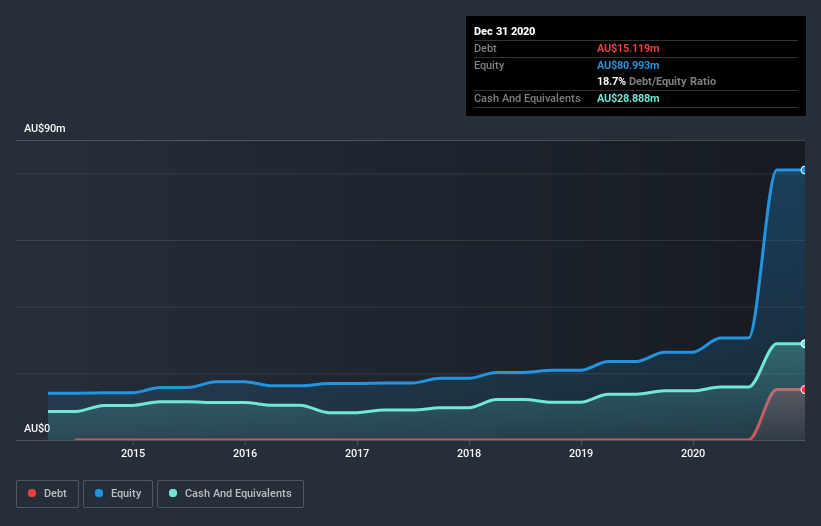Does Praemium (ASX:PPS) Have A Healthy Balance Sheet?
David Iben put it well when he said, 'Volatility is not a risk we care about. What we care about is avoiding the permanent loss of capital.' So it seems the smart money knows that debt - which is usually involved in bankruptcies - is a very important factor, when you assess how risky a company is. As with many other companies Praemium Limited (ASX:PPS) makes use of debt. But is this debt a concern to shareholders?
When Is Debt A Problem?
Generally speaking, debt only becomes a real problem when a company can't easily pay it off, either by raising capital or with its own cash flow. Ultimately, if the company can't fulfill its legal obligations to repay debt, shareholders could walk away with nothing. However, a more usual (but still expensive) situation is where a company must dilute shareholders at a cheap share price simply to get debt under control. Of course, the upside of debt is that it often represents cheap capital, especially when it replaces dilution in a company with the ability to reinvest at high rates of return. The first step when considering a company's debt levels is to consider its cash and debt together.
See our latest analysis for Praemium
What Is Praemium's Net Debt?
The image below, which you can click on for greater detail, shows that at December 2020 Praemium had debt of AU$15.1m, up from none in one year. But on the other hand it also has AU$28.9m in cash, leading to a AU$13.8m net cash position.
A Look At Praemium's Liabilities
According to the last reported balance sheet, Praemium had liabilities of AU$21.4m due within 12 months, and liabilities of AU$15.4m due beyond 12 months. Offsetting these obligations, it had cash of AU$28.9m as well as receivables valued at AU$7.88m due within 12 months. So its total liabilities are just about perfectly matched by its shorter-term, liquid assets.
Having regard to Praemium's size, it seems that its liquid assets are well balanced with its total liabilities. So it's very unlikely that the AU$336.0m company is short on cash, but still worth keeping an eye on the balance sheet. While it does have liabilities worth noting, Praemium also has more cash than debt, so we're pretty confident it can manage its debt safely.
The modesty of its debt load may become crucial for Praemium if management cannot prevent a repeat of the 34% cut to EBIT over the last year. When it comes to paying off debt, falling earnings are no more useful than sugary sodas are for your health. When analysing debt levels, the balance sheet is the obvious place to start. But it is future earnings, more than anything, that will determine Praemium's ability to maintain a healthy balance sheet going forward. So if you're focused on the future you can check out this free report showing analyst profit forecasts.
Finally, while the tax-man may adore accounting profits, lenders only accept cold hard cash. While Praemium has net cash on its balance sheet, it's still worth taking a look at its ability to convert earnings before interest and tax (EBIT) to free cash flow, to help us understand how quickly it is building (or eroding) that cash balance. In the last three years, Praemium's free cash flow amounted to 39% of its EBIT, less than we'd expect. That's not great, when it comes to paying down debt.
Summing up
We could understand if investors are concerned about Praemium's liabilities, but we can be reassured by the fact it has has net cash of AU$13.8m. So we are not troubled with Praemium's debt use. When analysing debt levels, the balance sheet is the obvious place to start. But ultimately, every company can contain risks that exist outside of the balance sheet. For example - Praemium has 1 warning sign we think you should be aware of.
If you're interested in investing in businesses that can grow profits without the burden of debt, then check out this free list of growing businesses that have net cash on the balance sheet.
This article by Simply Wall St is general in nature. It does not constitute a recommendation to buy or sell any stock, and does not take account of your objectives, or your financial situation. We aim to bring you long-term focused analysis driven by fundamental data. Note that our analysis may not factor in the latest price-sensitive company announcements or qualitative material. Simply Wall St has no position in any stocks mentioned.
Have feedback on this article? Concerned about the content? Get in touch with us directly. Alternatively, email editorial-team (at) simplywallst.com.

